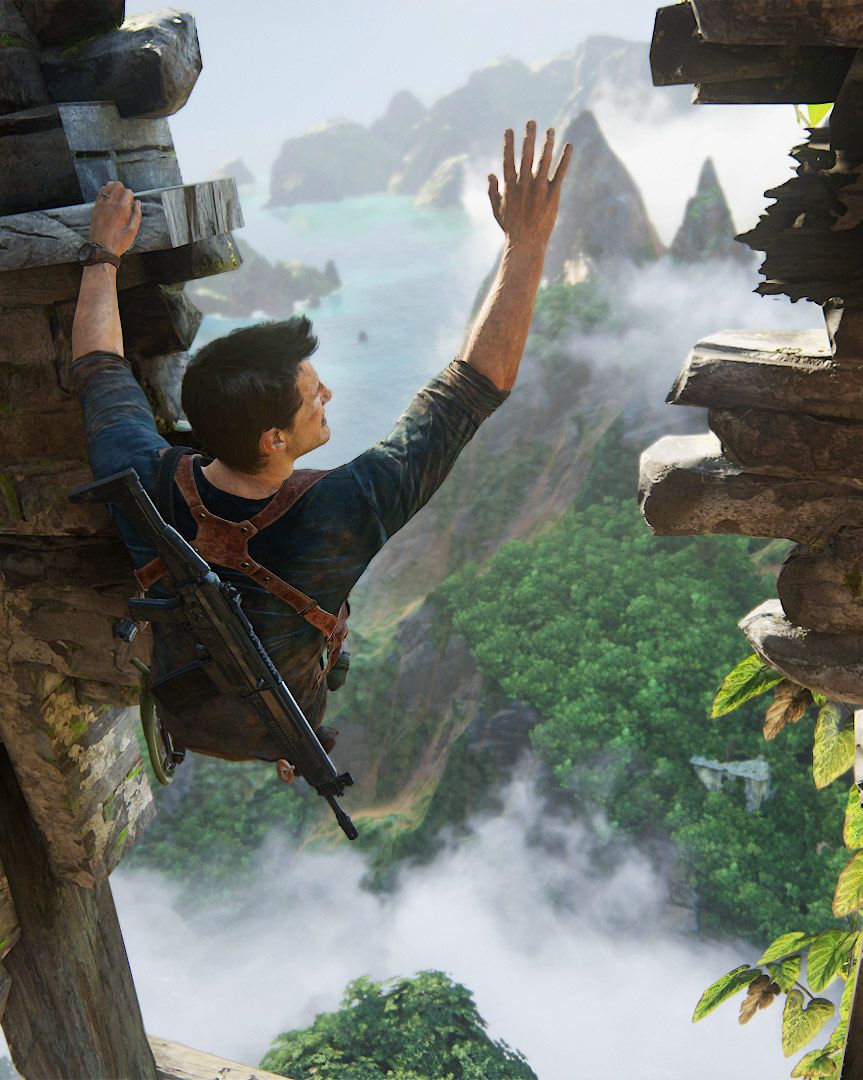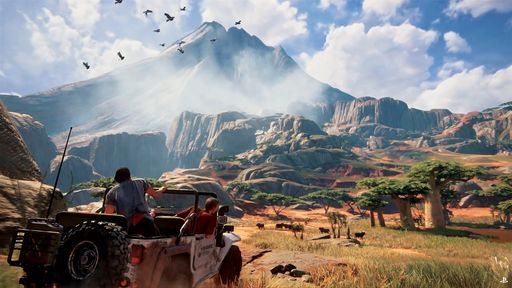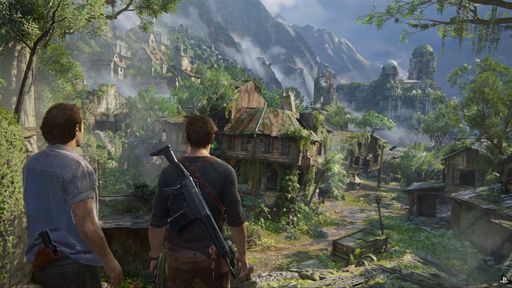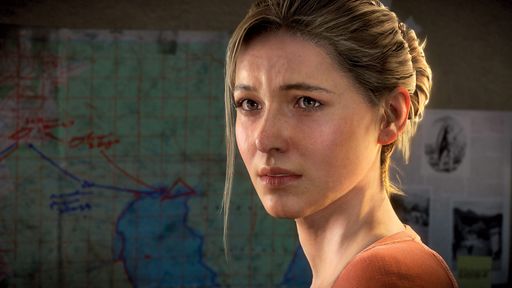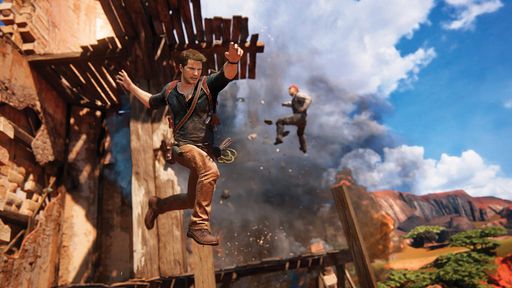In late April, the title of this year’s most anticipated video game became accidentally ironic when copies of Uncharted 4: A Thief’s Endwere stolen during the hijacking of a British delivery truck and sold on eBay two weeks before their intended May 10 release. As news of the robbery spread, along with illicit footage and screenshots from the PlayStation 4 tentpole, gaming blogs and message boards were flooded with concern—but not for the poor truck driver (whose condition wasn’t reported): “Really sucks to hear this,” wrote one compassionate commenter. “I hope people can avoid spoilers.”
You could be forgiven for wondering why anyone would care about the leaked plot details of a video game. Nobody has ever enjoyed Super Mario Bros. less for knowing in advance that Mario rescues the princess, or bailed early on a Dead Space, Halo, or Gears of War game just because they heard an alien supervillain dies at the end. But Uncharted is literally a different story, and for its latest installment — allegedly the last game in the 28 million-selling series, which will supposedly reveal the final fate of protagonist Nathan Drake — narrative resolution is as much of an attraction as the gameplay (which is fantastic), graphics (the best of any console game ever), or anything else that might persuade someone to spend $60 on it. Employees of Naughty Dog, the Sony-owned developer behind Uncharted, like to say they make “playable summer blockbusters,” but while lots of big-budget games evoke Michael Bay, Naughty Dog’s are warmly Spielbergian, emphasizing plot and character even amid gunfights and zombie apocalypses.
Naughty Dog’s headquarters, a cubicled spread in the middle of an anonymous Santa Monica office park, sits a few miles west of where most non-playable blockbusters are hatched. But when I visited in July to talk to Neil Druckmann, the 37-year-old creative director and head writer of Uncharted 4 sounded less like a guy hyping a game or a movie and more like a TV showrunner promising closure in a series finale: “There won’t be an Uncharted 5, at least not from us,” he told me. “Maybe somebody will make a prequel, or they’ll do a sequel with different characters. But it’ll be really hard to do a sequel with Nathan Drake” — who, if I’m hearing correctly, will be killed, maimed, or somehow otherwise permanently retired in the climax of his latest adventure. I tell Druckmann this sounds like an iffy business move, and he admits he was worried about that too. “When I first had the pitch for the ending, I went into my boss’s office and asked, ‘Is Sony going to be okay with this?’ This is a flagship title for them, at the height of its popularity.”
Naughty Dog has parted ways with valuable intellectual property before. In the ’90s, it was best known as the studio behind the Crash Bandicoot games, whose title character, a surly marsupial who bounced around cartoon jungles exuding PG-13 attitude, was PlayStation’s edgy answer to Mario and Sonic the Hedgehog. The studio lost rights to Crash after four games, so it moved on with Jak and Daxter, a fantasy–sci-fi series that sent the elf-like Jak on a quest to undo his friend Daxter’s accidental transformation into an otter-weasel hybrid. Naughty Dog’s games have always been well made, with graphics, voice acting, and level design several notches above its competitors. But on 2007’s Uncharted: Drake’s Fortune, the writing caught up.
Uncharted’s Nathan Drake is a modern-day treasure hunter who follows the maps of famous explorers to mythical MacGuffins like El Dorado (Drake’s Fortune), the Cintamani Stone (2009’s Uncharted 2: Among Thieves), and the lost city of Ubar (2011’s Uncharted 3: Drake’s Deception). Drake is a whiz at solving puzzles and can read the writing on any cave wall no matter what defunct language it’s in, but he can’t seem to go five minutes without tipping off bad guys to the location of the priceless artifact he’s pursuing, and he and his companions—usually his former girlfriend and current wife, Elena, and treasure-hunting mentor Sully—often find themselves being double-crossed, thrown out of cargo planes, and chased by henchmen through collapsing ruins. Basically, these are interactive Indiana Jones movies, with motion-capture acting and action-adventure cinematography good enough to be confused for the real thing. (Columbia Pictures has been trying to make a live-action Uncharted movie since 2009. David O. Russell took a turn at the script.)
In Uncharted 4, set a few years after Uncharted 3, Nathan Drake has settled into ordinary life with Elena, working for a marine salvage outfit that rescues non-priceless artifacts from drowned shipping containers. But then his long-missing older brother, Sam, shows up claiming to be in debt to some dangerous people who will kill him unless he and Nathan can lead them to pirate treasure. Druckmann was a little vague about why Naughty Dog decided to make this Uncharted’s final chapter, but when I asked for clarification, the company sent me an official statement: “Nate has been struggling his entire life [with] an obsession with lost treasure,” which has “damaged his personal relationships time and time again. We felt that to address this internal conflict one way or the other would be to ‘complete’ the character.”
The development of Uncharted 4, which began a little over four years ago, had its own plot twists. Amy Hennig, Naughty Dog’s former creative director who helmed the first three Uncharted games, left the company in March 2014 for never-explained reasons, passing the reins to Druckmann and game director Bruce Straley (who worked with her on the first two Uncharted games). Several other employees followed Hennig out the door, and a couple of Uncharted 4’s motion-capture stars made public gripes, including Nolan North, who plays Drake: “We had shot eight months of [Hennig’s] story, and it was all thrown away.” (Hennig, who now works for Electronic Arts, declined to comment.)
There was some initial worry about the regime change. “There’s a story that got out there about how I wanted to kill Elena in Uncharted 2, which is true,” says Druckmann. “I was pushing for that, but it wasn’t my call. So now everyone thinks, ‘Oh my God, Neil is going to kill Elena?’” Excitement for Uncharted 4 held steady, though, in part because Druckmann and Straley’s last major project for Naughty Dog was 2013’s survival-horror game The Last of Us, one of the most acclaimed games of the past decade. The premise: A brain-eating fungal infection has turned most Americans into zombielike creatures. You play as Joel, a 40-something man whose own daughter has died, escorting Ellie, a 14-year-old girl with an immunity to the disease, on a cross-country trip to visit doctors who might be able to turn her blood into a vaccine. If Uncharted is Indiana Jones, The Last of Us is The Road. Yes, you stab and strangle thousands of zombies over 20-odd hours of gameplay, but the real hook is the emotional action between main characters, who form a bond as plausible as any on, say, The Walking Dead. (The music by two-time Oscar winner Gustavo Santaolalla and near-photorealistic graphics help.) Even though reviews included descriptors like “literary,” The Last of Us sold more than 12 million copies.
GAMING
Scenes from Uncharted 4: A Thief’s End.
Photographs Courtesy of Sony
Indie developers have conducted some interesting narrative experiments lately — I recommend Firewatch, Gone Home, and Life Is Strange — but the mainstream success of such assertively story-driven games as Naughty Dog’s is unusual in an industry that mostly sells omnipotence. The top-ten best sellers of 2015 included three first-person shooters (Star Wars: Battlefront and two Call of Dutys), three sports games (Madden NFL 16, NBA 2K16, and FIFA 16), a fighting game (Mortal Kombat X), an action role-playing game (Fallout 4), a world-building simulator (Minecraft), and a world-wrecking simulator (Grand Theft Auto V), most of which either lack plots completely or have only a few wisps of exposition. Fallout 4 and GTAV do have stories, but both allow players to choose their own adventures in ways that Naughty Dog games never would.
For example, there’s nothing you can do to alter the one predetermined ending of The Last of Us or an Uncharted game, or the sequence in which their events unfold. Naughty Dog’s games comply with the rules of filmic three-act story structure, which Druckmann is more obsessed with than most movie writers. Famed Hollywood script doctor Damon Lindelof recently claimed to this magazine that he’d never heard of Save the Cat!, Blake Snyder’s trendy screenwriting manual whose 15-point “beat sheet” formula seems to be the blueprint for most modern blockbusters. But Druckmann has not only heard of it: “I’ve used it quite a bit,” he says. “I’ve also read Story, by Robert McKee, nine or ten times.”
Another thing Naughty Dog’s games won’t negotiate: their characters, whose looks and personalities are distinct and uncustomizable. In most popular games, protagonists are blank slates onto which players can transpose their own motivations. In first-person games, you might never see the hero’s face or hear them speak; in others, you can tweak your avatar’s gender, race, and appearance to match your own (or not). But Drake and Joel come with fixed appearances, dispositional traits, and emotional baggage that players can’t opt out of — if you don’t feel like controlling a gruffly charming white man, tough luck — and since Naughty Dog makes third-person games (which means the main character is always visible onscreen), you’ll never forget whose perspective you’re supposed to be playing from. “There’s a philosophical debate in games over whether a protagonist should be a cipher or a specific character whose eyes you’re going to see the world through,” says Druckmann. “I’m more intrigued with strong main characters that are specific in their will.”
At Naughty Dog, the production process begins with a story outline — “just all the major beats, and what parts of the world we’re going to be visiting and blowing up,” says Josh Scherr, Druckmann’s writing partner — and continues as a years-long collaboration between writers and game designers, during which scenes are written, rewritten, and as the gameplay comes into focus, sometimes rewritten again for maximum narrative impact. In July, Scherr, who says he’s usually the one fighting for levity, recalled a disagreement he’d had with Druckmann over a prison sequence in Uncharted 4: “In the script, Neil had a character being shot with a gun. I was like, ‘You don’t shoot people in prison, you shiv them.’ And he’s like, ‘The gun has to go off to alert the guards.’ And I was like, ‘But this is the villain doing this, and it would show he’s more intense.’ So there was this funny back-and-forth where I was arguing for the more violent death.” When I spoke with the pair in December, they told me they’d just moved a boat-chase sequence from the middle of the story to the beginning after realizing the game needed a grabbier cold open.
At some studios, designers might grumble about having to make so many changes to accommodate a story, but at Naughty Dog, “design follows narrative, and every level designer is absorbed in what the story is doing,” says Tom Bissell, a literary writer working in games who contributed to Uncharted 4. “I’ve worked at half a dozen studios now, and at a lot of them, it’s a miracle if the level designers even read the scripts. But [at Naughty Dog], they’ll bend over backward to for a cool narrative moment, even if it’s an idea that sounds unworkable in terms of gameplay.”
One unworkable-sounding narrative moment comes near the beginning of Uncharted 4. “When I first heard Neil pitch the idea, I thought, Well, that’s insane,” says Bissell, “but then I played it.” In it, a domesticated Drake is puttering around his attic remembering past adventures. As he notices artifacts from the first three games, he picks them up, and “the way he sighs, you can tell he misses this stuff,” says Druckmann. “And on the ceiling, he’s hung these targets of enemies he’s faced—like the yeti monsters from Uncharted 2 — and you pick up a toy gun, the music from Uncharted 1 kicks up, and you shoot plastic balls at the targets.” Not exactly the pulse-raising action most gamers are accustomed to, but, Druckmann says, “it was a way to get you to play Drake’s emotions.”
In many games, emotional moments are confined to the cutscenes (i.e., the noninteractive animated sequences between levels). But what Naughty Dog games do exceptionally well is incorporate narrative into the gameplay itself to forge an empathetic bond between you and a character unlike you. For example, in a flashback sequence in Uncharted 4, a young Nathan Drake escapes from an orphanage with help from Sam (who no longer lives there), sneaking out a window, climbing chimneys, and leaping between rooftops. The point of the level is twofold: to illuminate Nathan’s early relationship with his brother, whom he idolizes, and to reacquaint the player with Uncharted’s climbing mechanics. Sam praises Nathan for every jump he makes, and for successfully tossing a grappling hook. But at level’s end, when Sam offers him a ride on a new motorcycle, Nathan realizes something is up: “The only time you pull a stunt like this is when you’re trying to make up for something,” Nathan says. And he’s right — Sam claims to have a job that requires him to leave town for a year. As I fumbled a bit through this part of the game, I came to appreciate my wiser companion’s encouragement and climbing tips (and anguished screams whenever I fell to my death), so when I found out he was deserting me, I actually felt a hint of Nathan’s disappointment.
A similar trick is used to more jarring effect at the end of The Last of Us (which I’m going to spoil — sorry). Joel delivers Ellie to the doctors who might be able to save humanity, but then he learns they can only create a vaccine by studying her brain postmortem, which sends him on a killing spree through the hospital. When he reaches the operating room where Ellie is being prepped for surgery, the game forces the player to save her by shooting a doctor. “In the beginning of the game, Joel is saying and thinking stuff that most players would, so emotionally you’re in line with him,” says Druckmann. “But toward the end it starts to diverge. Some people will reach the operating room and try to turn back. I like the idea that they can’t proceed without becoming Joel. This is his story. It’s not your story. You’re going to have to shoot that doctor.”
In other words, Naughty Dog’s games are playing you, and if they really have decided to kill Nathan Drake at the end of Uncharted 4, there’s a good chance they’ve found a way to make you feel complicit. But from what I’ve heard, Drake’s prognosis is good: “Depending on how much money this game makes, Sony might want to do another one with another studio,” says Nolan North. “And I would certainly come back.” Druckmann, though, sounds done, especially when I ask him about his favorite part of Uncharted 4. “Close to the end, a character is talking to another about one thing,” he says. “But there’s something very different on their mind, and they’re being jokey in the conversation, but as soon as they’re left alone, there’s a split-second where they look over their shoulder, and you see them having to let go. That really resonates with me.”
*A version of this article appears in the May 16, 2016 issue of New York Magazine.
